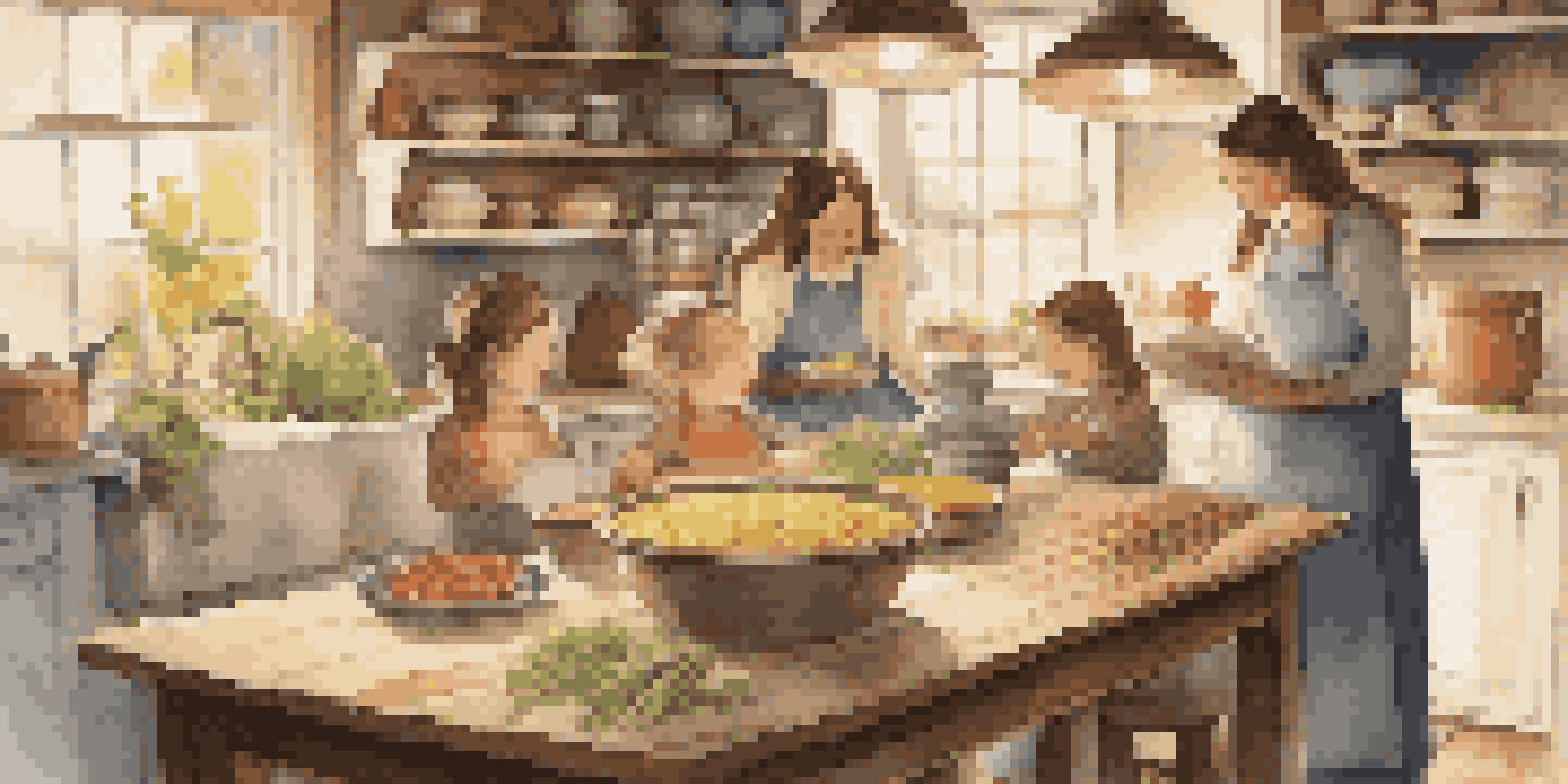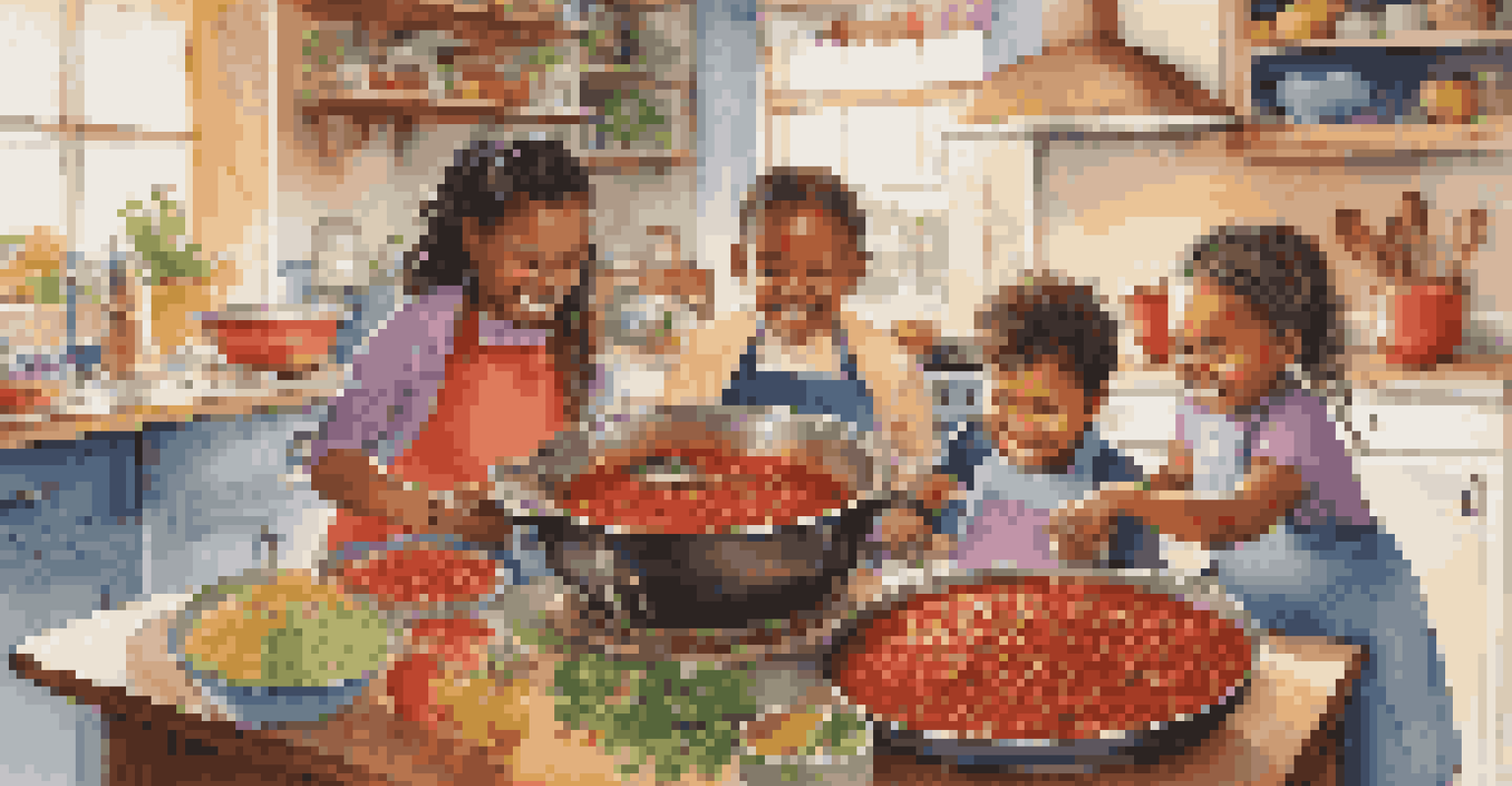Historical Cooking for Modern Families: Recipes to Try Today

The Joy of Rediscovering Historical Recipes
There’s something magical about diving into the past through food. Historical recipes offer a glimpse into the daily lives, traditions, and cultures of families long ago. When you cook these dishes, you’re not just preparing a meal; you’re sharing a story that connects generations.
Food is our common ground, a universal experience.
Cooking together as a family can create lasting memories, and what better way to bond than over recipes that have stood the test of time? Gathering around the kitchen to try your hand at a dish from the 1800s can spark conversations about history, heritage, and the evolution of our culinary practices.
Moreover, these recipes often use simple, fresh ingredients that are still accessible today. By reviving these historical dishes, families can enjoy healthier meals while also introducing their children to the joys of cooking and the importance of food in our collective past.
Exploring Colonial American Cuisine
Colonial American cuisine reflects the diverse influences of indigenous peoples and European settlers. Dishes like cornbread, baked beans, and hearty stews were staples that families relied on for sustenance. These recipes are not only delicious but also provide a glimpse into the resourcefulness of early American families.

One popular dish to try is ‘Johnny Cakes,’ a simple cornbread that can be served with honey or butter. It’s easy to make and perfect for breakfast or as a side dish. Just mix cornmeal, salt, and water, then cook it on a griddle for a delightful taste of history.
Rediscover Family Traditions
Historical recipes create opportunities for families to bond over shared culinary experiences and explore their heritage.
By incorporating these dishes into your family's meal rotation, you’re not just filling bellies; you're also nurturing a sense of curiosity about where our food comes from. It’s a fun way to engage kids in the kitchen while teaching them about the cultural significance behind each dish.
Victorian-Era Delicacies to Delight the Family
The Victorian era was known for its elaborate dining experiences, and many of these recipes can be adapted for modern families. Dishes like ‘Potted Meat’ and ‘Steak and Kidney Pie’ might sound a bit fancy, but they can be simplified for a cozy family dinner. These recipes often celebrate hearty ingredients and rich flavors.
Cooking is like love. It should be entered into with abandon or not at all.
For a family-friendly version, consider making a ‘Meat Pie’ with ground beef, veggies, and store-bought pastry. It’s an easy way to introduce the concept of pies while keeping it accessible for busy weeknights. Plus, kids can help with filling and sealing the pastry!
This exploration of Victorian cooking can also lead to interesting conversations about etiquette and mealtime traditions. Sharing these stories while enjoying a classic dish can enhance the dining experience, making it both educational and enjoyable.
The Simplicity of Medieval Cooking
Medieval cooking is often misunderstood, but it was based on simplicity and seasonality. Ingredients were sourced locally, which is an excellent lesson for modern families looking to eat sustainably. Dishes like porridge, stews, and roasted meats were common, often flavored with herbs and spices.
A simple medieval dish to try is ‘Pottage,’ a hearty stew made with whatever vegetables and grains you have on hand. This flexible recipe encourages creativity in the kitchen and helps reduce food waste, as you can use up leftover ingredients.
Engage in Cultural Exploration
Cooking dishes from various cultures fosters appreciation for diversity and adds exciting flavors to family meals.
Cooking medieval dishes invites families to think about the history of food preservation and the significance of local produce. It’s a fun way to connect with the past while making nutritious meals that the whole family can enjoy.
Renaissance Recipes for Family Gatherings
The Renaissance brought about a culinary revolution, with an emphasis on flavor and presentation. Recipes from this time often include unique spices and ingredients that can excite modern palates. Dishes like ‘Stuffed Duck’ or ‘Herb-Crusted Fish’ can transform a regular family dinner into a feast.
Consider making ‘Herb-Crusted Fish’ using fresh herbs and breadcrumbs for a simple yet impressive meal. This dish not only tastes fantastic but also infuses your kitchen with wonderful aromas that can draw the family together.
Exploring Renaissance cooking can also inspire creativity in meal presentation. By encouraging kids to help set the table or garnish dishes, you’re teaching them that food can be both delicious and visually appealing, making mealtime a special occasion.
Global Influences of Historical Cooking
As families explore historical recipes, it's essential to recognize the global influences that have shaped our cuisines. From spices brought back by explorers to traditional recipes passed down through generations, our food history is rich and diverse. Dishes from various cultures can offer exciting new flavors and experiences.
For example, try making ‘Chili con Carne,’ a dish with roots in Mexican and Texan history. It’s a hearty meal that’s easy to prepare and perfect for family gatherings. Plus, you can adjust the spice levels to suit your family’s taste.
Create Lasting Memories Together
Involving children in the cooking process nurtures life skills and strengthens family connections through shared traditions.
Cooking dishes from different cultures can open up discussions about customs and traditions, fostering an appreciation for diversity in food. It’s a delicious way to bring the world to your dinner table, making every meal an adventure.
Cooking as a Family: The Heart of Historical Recipes
At the core of historical cooking is the idea of family togetherness. Many traditional recipes were created to feed large families and often involved everyone pitching in. This collaborative spirit is essential for creating a sense of belonging and teamwork in the kitchen.
Encouraging kids to take on specific tasks—like measuring ingredients or stirring pots—can help them develop valuable life skills while making them feel included. Cooking can become a cherished family ritual that everyone looks forward to, creating a bond that lasts beyond the meal.

Ultimately, the goal is not just to recreate historical dishes but to foster connections through food. By sharing recipes, stories, and experiences, families can celebrate their heritage while creating new traditions that will be passed down for generations.
Tips for Incorporating Historical Recipes into Modern Life
Incorporating historical recipes into your family’s cooking repertoire doesn’t have to be overwhelming. Start small by selecting one or two recipes to try each month. This approach allows everyone to enjoy the process without feeling rushed, making it a more enjoyable experience.
Consider creating a family cooking night where everyone can participate in preparing a historical dish together. This can become a fun tradition that not only teaches cooking skills but also provides an opportunity to explore family history and culture.
Lastly, don’t forget to document the experience! Take photos, write down any changes you made to the recipes, and share your thoughts. This can create a family cookbook that celebrates your culinary adventures and preserves the memories for future generations.